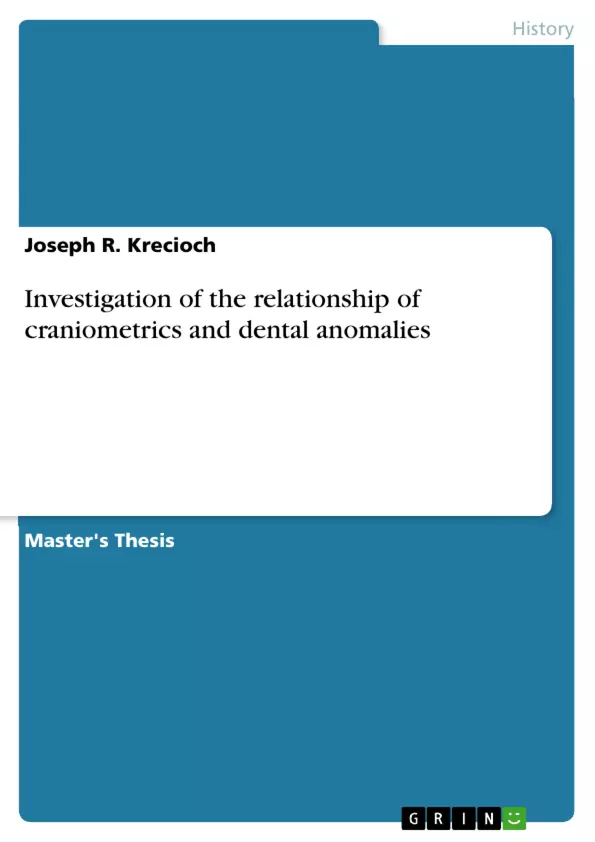Dental anomalies of number, shape, and position are frequently analysed in the orthodontic and clinical literature but are rarely discussed in an anthropological or archaeological context. While some of these anomalies are believed to follow Mendelian inheritance patterns and the importance of heredity is stressed, other developmental dental disorders are often hypothesised to be the result of a modern, urbanised lifestyle as a response to reduced masticatory stress and subsequent crowding of the dentition.
This study of 131 skulls and dentitions from 6 archaeological collections from England and Macedonia examines the relationship between craniometric variables and the expression of dental anomalies. A number of standard craniometric measurements were taken to estimate relative sizes of cranial functional complexes and determine whether or not, and to what extent, changes in the shape or size of these variables were associated with the expression of dental anomalies.
Statistical analyses determined that the null hypothesis, that there is no relationship between craniometrics and dental anomalies, can be rejected. A number of dental anomalies were found to have a relationship with reduced sizes in cranial and masticatory elements, although dental crowding was not as significant a factor in masticatory complex reduction. A cause and effect relationship cannot be determined but the data presented here suggests that both heredity and environmental causes may be influential in the expression of dental anomalies.
Keywords: anthropology, palaeopathology, palaeoepidemiology, craniometrics, epidemiology, orthodontics, dental, skull, dentition, crania, teeth, anomalies, Macedonia, England.
Inhaltsverzeichnis (Table of Contents)
- Introduction
- Literature Review
- Basis of human craniometric variation
- Craniofacial development
- Development of the masticatory complex
- Environment, heredity, and craniofacial development
- Occlusal variation and dental anomalies
- Materials and Methods
- Materials
- Methods
- Statistical Analysis
- Results
- Relationships between anomalies
- Discussion
- Preliminary craniometric analysis
- Relationships between dental anomalies and craniometrics
- Palaeoepidemiology and dental anomalies
- Dental anomalies and craniometrics
- Heredity, population variation and dental anomalies
- Arch dimensions and the aetiology of dental anomalies
Zielsetzung und Themenschwerpunkte (Objectives and Key Themes)
This dissertation investigates the relationship between craniometric measurements and the prevalence of dental anomalies in archaeological populations. By analyzing a collection of skulls and dentitions, the study seeks to understand the extent to which variation in the size and shape of the skull is associated with the expression of dental anomalies. The study aims to contribute to the anthropological understanding of human phenotypic variation and to further elucidate the complex aetiology of dental anomalies. The key themes explored in this dissertation include:- The relationship between craniometric variation and dental anomalies.
- The role of heredity and environmental factors in the development of dental anomalies.
- The influence of population variation on the prevalence of dental anomalies.
- The potential connection between dental anomalies and masticatory complex reduction.
- The contribution of this study to the understanding of human phenotypic variation and the aetiology of dental anomalies in an anthropological context.
Zusammenfassung der Kapitel (Chapter Summaries)
The introduction provides an overview of the study's aims and objectives, highlighting the lack of research exploring the relationship between craniometrics and dental anomalies. It emphasizes the importance of bridging the gap between anthropological and orthodontic perspectives on this topic. The literature review explores the existing knowledge on craniometric variation, craniofacial development, the development of the masticatory complex, the interplay of environmental and hereditary factors in craniofacial development, and the prevalence of occlusal variation and dental anomalies. The materials and methods section outlines the specific archaeological collections used in the study, the craniometric measurements taken, and the statistical analyses employed to examine the relationships between variables. The results chapter presents the findings of the study, including the distribution of dental anomalies across the different populations and the statistical significance of the relationships between specific craniometric variables and dental anomalies. The discussion section analyzes the results in depth, exploring the potential implications of the findings for understanding the aetiology of dental anomalies, the influence of population variation, and the role of masticatory complex reduction.Schlüsselwörter (Keywords)
The primary keywords and focus topics of this dissertation are: craniometrics, dental anomalies, anthropology, palaeopathology, palaeoepidemiology, morphology, orthodontics, skull, dentition, and heredity. The study examines the relationship between craniometric variation and the expression of dental anomalies in archaeological populations, focusing on the role of heredity and environmental factors in shaping this relationship.- Citation du texte
- MA, MSc Joseph R. Krecioch (Auteur), 2012, Investigation of the relationship of craniometrics and dental anomalies, Munich, GRIN Verlag, https://www.grin.com/document/274696



